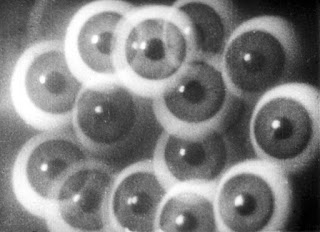Filmstudie (Hans Richter, 1926, Germany)
Filmstudie ("Film Study") is a 1926 short by Dada artist Hans Richter. Along with the Italian Futurists and other like-minded artists around the 1910s and 1920s, Richter was one of the first artists to apply the avant-garde to the cinema. Filmstudie is no exception - the film begins with abstraction, light dancing as a glowing orb rises to the top of the screen. Evoking what would appear later in Bunuel's Un Chien Andalou, we see a set of eyes appear overlaid against a set of repeated human faces.
The eye is a recurring motif in the film, as in the next stage we see several actual eyes and eye-like shapes dancing around the screen. As with many early avant-garde cinematic expressions, Filmstudie is self-reflexive about the act of vision itself. The patterns of eyes continue throughout, with variations that appear. Eventually the film transitions into geometric shapes - squares and rectangles that dance across the screen, flowing into and out of each other. The pattern of what appears to be a spotlight then emerges, eventually turning into the abstraction of white and black lines flowing across the screen.
The various lines of white and black intersecting throughout the film create a hypnotic effect. Nature briefly intrudes into the film, with footage of seagulls - albeit captured in a negative. The seagulls quickly disappear, however, and we are brought back into the motif of the eyeballs and faces.
While Filmstudie will not win over anyone who is not already interested in early avant-garde film, for those predisposed to be interested in this kind of filmmaking, Filmstudie is worth seeking out as an early example of the genre. Richter made many films in his native Germany before eventually being exiled by the Nazis. He eventually emigrated to the US where he lived for some time in New York and Connecticut.
6/10




Comments
Post a Comment